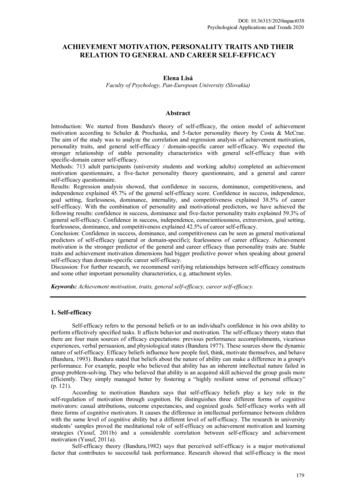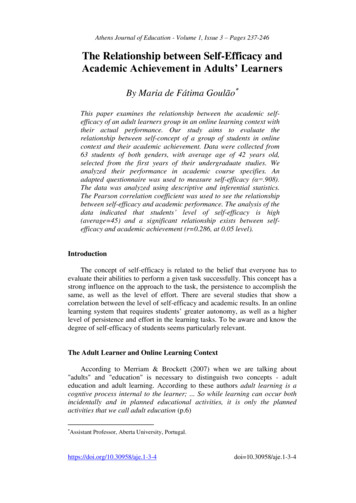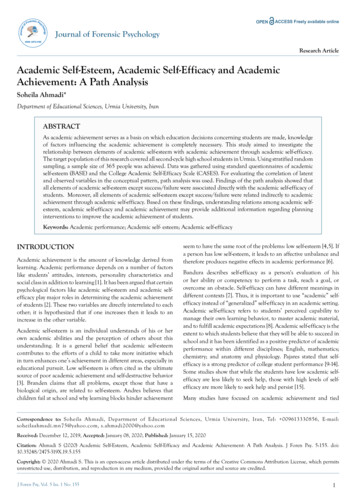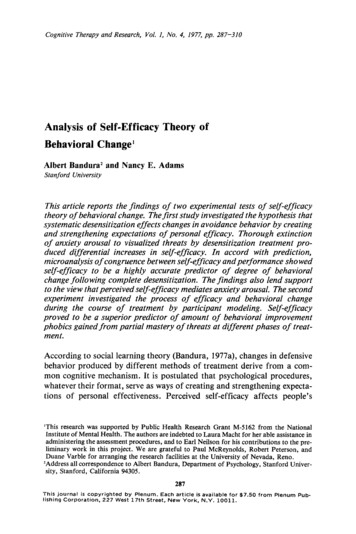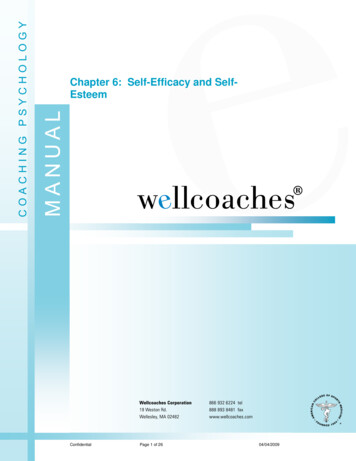
Transcription
Chapter 6: Self-Efficacy and SelfEsteemConfidentialPage 1 of 2604/04/2009
Chapter 6Self-Efficacy and Self-Esteem“Whether you think you can, or think you can’t, you’re right.”Henry FordChapter Contributor:Bob Tschannen-MoranAfter reading this chapter, you will be able to: Define and describe the similarities, differences, and relationshipbetween self-efficacy and self-esteem. Define and discuss the four sources of self-efficacy Demonstrate facility with using the four sources of self-efficacywithin a coaching program Demonstrate facility with a variety of positive psychologytechniques to build self-esteem Define and discuss how Appreciative Inquiry (Chapter 4) as wellas Nonviolent Communication, and Motivational Interviewing(Chapter 5) contribute to self-efficacy and self-esteem Flexibly utilize a wide variety of change strategies within acoaching session in order to assist clients to reach their positiveVision (or desired future)ConfidentialPage 2 of 2604/04/2009
Self-Efficacy: The End Game of CoachingSelf-efficacy, the belief that one has the capability to initiate or sustain adesired behavior, is one of the most important outcomes of coaching, incombination with improvements in self-image (becoming one’s best self)and lasting behavior change. We want our clients to not only achievethe goals that brought them into coaching; we also want them tobecome confident as to their ability to set new goals in the future and tohandle challenges as they arise. We want them, in other words, to learnhow to learn so that they can move on from coaching in self-directedand successful ways.Social Cognitive TheoryA primary resource for understanding self-efficacy is Social CognitiveTheory (SCT), officially launched in 1986 with the publication of AlbertBandura’s book, Social Foundations of Thought and Action: A SocialCognitive Theory. Simply put, SCT asserts that human behavior isdetermined by three factors which interact with each other in dynamicand reciprocal ways: personal factors (such as what we believe andhow we feel about what we can do), environmental factors (such as oursupport networks and role models) and behavioral factors (such as whatwe ourselves experience and accomplish). SCT is called a SocialCognitive Theory because it emphasizes the primacy of cognitiveprocesses in constructing reality and regulating behavior.Writing about flow, Mihaly Csikszentmihalyi captures this view:ConfidentialPage 3 of 2604/04/2009
“It is easier to become completely involved in a task if we believe it isdoable. If it appears to be beyond our capacity we tend to respond toit by feeling anxious; if the task is too easy we get bored. In eithercase attention shifts from what needs to be accomplished – theanxious person is distracted by worries about the outcome, while thebored one starts searching for other things to do. The ideal conditioncan be expressed by the simple formula: Flow occurs when bothchallenges and skills are high and equal to each other”(Csikszentmihalyi, 2003, p. 44).Self-efficacy is impacted by all three factors (personal, environmental,and behavioral) and masterful coaching works to align those factors inthe service of client goals. Bandura (1994, 1997) indicates that we dothis by paying attention to four sources of self-efficacy: physiological /affective states, verbal persuasion, vicarious experiences, and masteryexperiences. Combined with other bodies of knowledge, including theTranstheoretical Model of Change (TTM) (Chapter 3 and Prochaska, et.al., 1994), Appreciative Inquiry (AI) (Chapter 4 and Kelm, 2005,Whitney, et. al., 2003), Nonviolent Communication (NVC) andMotivational Interviewing (MI) (Chapter 5, Rosenberg, 2003, and Miller& Rollnick, 2002), Positive Psychology (Snyder & Lopez, 2002), andFlow (Csikszentmihalyi, 1990, 1993, 1997, 2003), Bandura’s work onself-efficacy and SCT can complement the coaching toolbox by bringinga unified conceptual framework to these different but related theories.ConfidentialPage 4 of 2604/04/2009
Physiological / Affective States – Cultivating Eustress, MinimizingDistressNothing is more personal than our bodies and our feelings, both ofwhich can interfere with self-efficacy. That’s why it’s so important toassist clients to become physically and emotionally comfortable with,rather than intimidated by, the prospect of change. The reasons forchange become motivational only when they engage the whole person,including our physical sensations and emotional reactions. Simply put,how we feel about the prospect of change impacts our self-efficacy. Ifwe have butterflies in our stomach or a dry throat, for example, we aremore likely to have low self-efficacy than if we are relaxed andconfident.That may seem obvious, but the cause and effect relationship goes bothways – physiological states affect self-efficacy and vice versa, andcoaches work to elicit both. Humorist and stress coach Loretta LaRoche(1998) points out that if we get our bodies to smile or laugh out loud,sooner or later our minds will figure out that we must be happy. It’s notalways clear which comes first, the chicken or the egg – the self-efficacybeliefs or the physiological / affective states – so it’s important to workon building them simultaneously.If stress is defined as stimulation, then distress represents either toomuch or too little stimulation. As noted above, the former provokesanxiety while the latter produces boredom. Both are distressing and, inthe extreme, both generate negative health-impacts, even to the point ofdeath.ConfidentialPage 5 of 2604/04/2009
Eustress, literally defined as “good stress,” represents the flow zone.We find ourselves engaged, but not overwhelmed; in control of ourexperience, but not bored. This is the sweet spot that coaches seek tohit with clients, both during the coaching conversation itself –challenging clients to stretch their thinking and feeling, while beingaffirmative and empathetic to avoid distress (Rosenberg, 2003) – andafter the coaching conversation, as clients actively pursue their visionand goals.Giving respectful attention and understanding to physiological / affectivestates, both during and between coaching sessions, can assist coachesand clients in finding that sweet spot. For example, during coachingconversations, coaches can offer empathy reflections (see Chapter 5) toelicit and connect with what clients may be feeling and needing in themoment. Coaches can also ask clients to change body position, tobreathe rhythmically, to move their hands, to walk around, to trace alabyrinth, to look at an object, to draw pictures, to play music, or toconnect in other ways with their physiological / affective states asdifferent actions are being contemplated and reviewed.The same is true for the coach’s own physiological / affective states,since they often mirror what the client is feeling and needing. The moreaware coaches become of their own sensations and feelings in themoment, as coaching conversations progress, the more on-targetcoaches become with their questions and interventions.ConfidentialPage 6 of 2604/04/2009
Getting clients to pay attention to their physiological / affective statesbetween coaching sessions is equally vital in assisting clients to moveforward. Noticing and understanding what’s happening on an emotionallevel while clients are experimenting with behavior changes can assistclients to discover the things that fill them with or drain them of energy.Self-efficacy increases as clients do more of the things that fill them withenergy. This amounts to setting aside doing things out of a sense ofobligation or “should” in favor of doing things out of a sense of choiceand “want”. When the locus of control shifts from the external to theinternal frame, clients find more energy, motivation, and greaterconfidence to change.Verbal Persuasion – Evoking Change TalkMany different environmental factors impact self-efficacy; two of themost important are the things people say to us (verbal persuasion) andthe things people do around us (vicarious experience). Each will beconsidered in turn, as separate sources of self-efficacy.Verbal persuasion is not about wearing the expert hat and telling peoplewhat they should do. As we have seen in our study of MI (see Chapter5), that typically generates both resistance and resentment. Wearing theappreciative hat and stimulating someone to discover what they can dois, however, an entirely different matter. Inputs such as these tend toenrich life and generate movement as clients become persuaded thatthey have what it takes to initiate and maintain a desired behavior.ConfidentialPage 7 of 2604/04/2009
IMPORTANT: The more coaches try to persuade clients of what they“should” do, the more resistance coaches evoke, which decreasesreadiness to change.To assist clients to become persuaded without provoking resistance,coaches need to communicate confidence in the ability of clients toreach their vision and achieve their goals. When that confidence isheartfelt, sincere, and based on client strengths, it does much to bolsterself-efficacy. It may take time and many such verbal inputs, from avariety of socially-interactive phenomena, but client inertia can beovercome. As Bandura writes:“Social persuasion serves as a further means of strengtheningpeople’s beliefs that they possess the capabilities to achieve whatthey seek. It is easier to sustain a sense of efficacy, especially whenstruggling with difficulties, if significant others express faith in one’scapabilities than if they convey doubts.”“Verbal persuasion alone may be limited in its power to createenduring increases in perceived efficacy, but it can bolster selfchange if the positive appraisal is within realistic bounds. People whoare persuaded verbally that they possess the capabilities to mastergiven tasks are likely to mobilize greater effort and sustain it than ifthey harbor self-doubts and dwell on personal deficiencies whendifficulties arise.”“To the extent that persuasive boosts in perceived efficacy leadpeople to try hard enough to succeed, self-affirming beliefs promoteConfidentialPage 8 of 2604/04/2009
development of skills and a sense of personal efficacy . To raiseunrealistic beliefs of personal capabilities, however, only invitesfailure that will discredit the persuaders and further undermine therecipients’ beliefs in their capabilities” (Bandura, 1997, p. 101).Coaching represents one of those verbal inputs. Our job is not only toassist clients with the decisional balance of weighing pros and cons; it isalso to help clients acquire the belief that they have what it takes tomove forward and that life will support them in wonderful ways, oncethey get started. Dave Buck, CEO of CoachVille, a social network forcoaches, frames the persuasive work of coaching in these terms: “Mycertainty is greater than your doubt.” Such persuasion involves allaspects of being, including the cognitive, emotional, physical, andspiritual domains. It hinges on the credibility of the coach and the qualityof the coaching relationship.Bandura’s recognition that verbal persuasion must be appropriatelyscaled reflects the basic insight of the TTM vis-à-vis the stages ofchange (see Chapter 3 and Prochaska, et. al., 1994) as well asCsikszentmihalyi’s work on flow (1990, 1993, 1997, 2003). Masterfulcoaches dance with their clients to set appropriate, stage-specificchallenges and to identify the relevant skills to be learned over time.When this happens, the coaching relationship can remain productiveindefinitely since there are always new challenges to tackle and newskills to learn.AI (see Chapter 4) is an especially powerful framework and process forassisting clients to become persuaded that they have what it takes to doConfidentialPage 9 of 2604/04/2009
what they want to do. By evoking the stories of their best experiencesand exploring their core values, generative conditions, and heartfeltwishes, clients become empowered to dream, design, and deliver theirdestiny.When clients express resistance, the TTM (see Chapter 3) as well asNVC and MI (see Chapter 5) are invaluable tools. Resistance may comefrom the coach’s inaccurate assessment of a client’s readiness tochange, from setting a challenge that does not match the client’scapacity, or from formidable systemic obstacles. Resistance may alsodevelop when coaches speak from the expert position, telling clientswhat they “need,” “should,” or “have” to do in order to reach their goals.MI uses many tools to avoid provoking resistance, including expressingempathy, silence, attentiveness, open-ended questions, as well as avariety of reflective listening statements. These and other MI tools havethe ability to shift the client from resistance-talk to change-talk, thusincreasing the client’s perceived self-efficacy.Bandura (1994) notes that it is far easier to discourage someone withour words than to encourage them. The wrong words spoken at thewrong time can undermine confidence and produce disappointingresults. Wearing the expert hat can overwhelm and intimidate ratherthan empower and inspire. It’s better to listen and remain silent than topush the wrong buttons in our attempt to get things moving.ConfidentialPage 10 of 2604/04/2009
Vicarious Experiences – Observing Similar Role ModelsThe world’s first commercial bungee jumping took place in November,1988 off the Kawarau Bridge in Queenstown, New Zealand. The 43meter drop (141 feet) continues to attract thousands of visitors eachyear, who find it fascinating to watch the process of someone decidingto take the plunge. When people arrive, they first go to the viewingplatforms, one high and the other low. They watch people, of differentgenders and ages, get strapped in and dive off the bridge into thegorge. With each successive jump, some become more interested,open, and confident. They develop the belief that “I can do that too.”Their self-efficacy increases by the vicarious experience of watchingothers.Such experiences are yet another vital environmental factor when itcomes to self-efficacy. The more opportunities people have to witnessand relate to others who are doing what they want to do, the more likelyit is that they will initiate and sustain that behavior themselves(Deutschman, 2007).Sharing and telling stories are other ways for clients to have efficacybuilding, vicarious experiences. We can use the Appreciative InterviewProtocol (see Chapter 4), for example, to encourage clients to tellstories of others who have successfully handled their current goals andchallenges. Coaches can also tell stories from their own life experienceand the experience of others they have worked with or known. Themore positive change stories coaches and clients share together, theConfidentialPage 11 of 2604/04/2009
more vicarious experiences come into the coaching conversation – andthe more self-efficacy grows.It’s better to encourage clients to find their own stories of vicariousexperience rather than to tell our stories, but both can come into playover the course of a coaching conversation. When coaches tell toomany stories, it can sound either boastful (“Look what I did!”) ordemanding (“All these people got their act together! Why can’t you?”).When stories are told judiciously, however, as part of the give and takeof the coaching conversation, they serve as powerful tools to generatethe energy for change.If and when clients are unable to come up with their own stories ofvicarious experience, coaches can encourage them to do research andfield studies. To use the analogy of bungee jumping, coaches can assistclients to find a platform from which to watch others do what they wantto do. When this happens, their self-efficacy is likely to increase. Themore success stories clients have in their repertoire, and the more theytell those stories both to their coach and to others, the more likely itbecomes that they will see themselves as able to achieve their desiredoutcomes.That’s especially true if the stories describe people similar tothemselves. The greater the perceived similarity, the greater the impacta vicarious experience will have on self-efficacy. Why do some peopledecide to jump off the Kawarau Bridge while others demur, even thougheveryone has the same vicarious experience? It may have to do, in part,with how closely one identifies with those who actually take the plunge.ConfidentialPage 12 of 2604/04/2009
Mastery Experiences – Successful, Perseverant EffortsThe final SCT factor, the behavioral factor, is both the most powerfulsource and the ultimate outcome of self-efficacy. What we actuallyaccomplish ourselves does more than anything else to cultivatesuccessful, perseverant effort. As the old saying goes, “Nothing breedssuccess like success.” Conversely, “Nothing breeds failure like failure.”Understanding this dynamic, masterful coaches assist clients to achievequick wins and then to stay on the winning path from week to week.Positive outcomes lead to increased self-efficacy while negativeoutcomes lead to decreased self-efficacy. That’s why masteryexperiences can be viewed as both cause and effect when it comes toself-efficacy.That’s as true in coaching as it is in other areas. Masterful coaches do abetter job of dancing with their clients than uncertain or insecurecoaches. As a result, masterful coaches generate better results andattract more clients – both of which serve to enhance their sense of selfefficacy as coaches. Instead of a destructive cycle down, masteryexperiences generate a constructive cycle up.IMPORTANTTo increase the frequency, intensity, and quality of their clients’ masteryexperiences, masterful coaches discern where clients are in the TTMStages of Change and then guide them to structure stage-appropriate,incremental goals that are both exciting and manageable. The goals areSMART: Specific, Measurable, Action-based, Realistic, and Time-lined.ConfidentialPage 13 of 2604/04/2009
As Csikszentmihalyi observes, biting off either too much or too littleundermines self-efficacy because doing so generates either anxiety orboredom.This is where the research studying flow and self-efficacy converge.People with high self-efficacy experience flow more often than peoplewith low self-efficacy because they know how to set goals and designprojects that are just within reach. Masterful coaches use a combinationof objective and intuitive data to provide transformational feedback totheir clients through the process of goal setting and implementation.Assisting clients to approach their lives as science experiments or livinglaboratories can free clients to try new things and to bounce back fromapparent failure. There are no failures in science, only learningexperiences. Science is a “win-learn” rather than a “win-lose” enterprise.Data are collected and theories are revised until things work and fittogether; so too when it comes to mastery experiences. If somethingdoesn’t work, we use that data to design new experiments until we findsomething that does work. As in AI, coaches come from the perspectivethat we can always find things that work.It is important for coaches to assist clients to find things that areimportant, interesting, enjoyable, and stage-appropriate from thevantage point of the client. There is no point in conducting anexperiment for its own sake. It must be related to a larger, positivevision of who we are and where we want to go. It must also begrounded in the reality of what clients know and have accomplished inthe past (see Chapter 4). Masterful coaches enable their clients toConfidentialPage 14 of 2604/04/2009
frame their goals and projects in these terms. They are masters ofmeaning, learning, and joy.Self-Esteem: The Bedrock of CoachingSelf-esteem, the belief that one has value and self-worth as a person,represents the bedrock of coaching since no progress is possible untilthat foundation is secure. People with very low self-esteem may, in fact,benefit more from therapy than from coaching and an appropriatereferral should be considered. That’s especially true if the followingpositive-psychology practices fail to elevate self-esteem in a reasonableamount of time.Positive PsychologyPositive psychology, formally embraced by the American PsychologicalAssociation as its theme for the year in 1998 under the leadership ofMartin Seligman, has subsequently identified and documented the valueof numerous interventions for enhancing self-esteem (including theelevation of self-efficacy, (Lyubomirsky, Tkach, & DiMatteo, 2005).Although such interventions may not produce positive behavioraloutcomes in and of themselves, they do make those outcomes morelikely, improving the life-experience of clients.When it comes to health, fitness, and wellness, it is interesting to notethat those with low self-esteem are “apparently more prone than othersto get sick or suffer other physical problems in connection with stressfuldaily events” (Baumeister, Campbell, Krueger, & Vohs, 2003, p. 27).ConfidentialPage 15 of 2604/04/2009
Given the increasing prevalence of stress in modern society, this findingalone is reason enough to coach people to higher levels of self-esteem.Seligman (2002) frames the process of enhancing self-esteem inchronological terms. He proposes exercises to develop a positiveappreciation of and relationship to the past, present, and future. Byworking with memories, emotions, and trajectories, Seligman and otherpositive psychologists (Wallis, 2005, Lyubomirsky, 2007) have mappedout a variety of simple processes for elevating attitudes andexpectations.Positive Past – Elevating MemoriesGratitude. The positive past requires a sense of gratitude for the past,no matter how difficult, twisted, or painful. One thing is certain: the pasthas gotten us to where we are today. Cultivating gratitude for the pastcan be done in many ways. One technique is the Gratitude Visit, whichinvolves writing a thank-you letter to someone who has had a positiveimpact on our life. Once the letter is written, we deliver it, ideally inperson, and read it to the intended beneficiary of our gratitude(Seligman, 2002, p. 72). Another is to create and share GratitudeJournals at regular intervals, for example list ten things we are gratefulfor that happened in the past year, or even decade.Forgiveness. The positive past also requires a measure of forgivingand forgetting. The more difficult, twisted, or painful the past, the moreforgiveness will be required. To muster that posture, Seligmanrecommends a five-step process that goes by the acronym of REACH:ConfidentialPage 16 of 2604/04/2009
Recall the hurt, in as objective a way as possible. Empathize and try tounderstand, from the perpetrator’s point of view, why this person didwhat they did. Give the Altruistic gift of forgiveness. No one is entitled toforgiveness, but it can be offered. Commit to forgive publicly. Write itdown and share that altruistic gift with at least one other person. Holdonto forgiveness, even when negative memories resurface. Remindyourself that you have forgiven, reviewing what you have written, whenthose memories loom large (Seligman, 2002, pp. 79-81).Satisfaction. Finally, the positive past requires a sense of satisfactionwith the domains of life that are important to an individual. Seligmanrecommends an annual self-appraisal, using a 10-point scale fromabysmal to perfect. Combined with a few notes regarding each ruler asto why things are the way they are – not higher or lower – this exerciseleaves little room for self-deception and suggests future actions(Seligman, 2002, pp. 81f).Positive Present – Elevating EmotionsMindfulness. The positive present requires us to notice what ishappening in the here and now. There is no way to come into a positiverelationship with that which is outside of our awareness. Slowing downis often the first step. It’s difficult to pay attention when things go by atwarp speed. Breathing, driving, eating, talking, and walking are allthings that can be done more slowly in order to increase mindfulawareness of what is going on both around us and in us. (Seligman,2002, p. 110) Ending the day by writing down three to five positivethings that happened and for which we are grateful in a GratitudeConfidentialPage 17 of 2604/04/2009
Journal is a simple exercise that can both increase mindfulness andelevate affect in the positive present.Savoring. The positive present also requires us to appreciate what ishappening in the here and now. Once we have slowed down enough tonotice what is going on, it behooves us to savor and relish theexperience. Basking (receiving praise and congratulations),thanksgiving (expressing gratitude for blessings), marveling (losing theself in the wonder of the moment), and luxuriating (indulging the senses)are four kinds of savoring. To experience these, Seligman recommendsa five-step process: Share the moment with others, capture the momentfor posterity, self-congratulation, sharpening perceptions, andabsorption (p. 108).Flow. Finally, the positive present requires us to participate joyfully inwhat is happening in the here and now. Mihaly Csikszentmihalyi (1990,1993, 1997, 2003) describes this as “flow”, which he defines as beingfully engaged with challenges that are just about manageable. Bypaying attention to whether we are anxious or relaxed, aroused orbored, in control or worried, we can advance our opportunities andcapacities in order to optimize our experience of the positive present.Positive Future – Elevating TrajectoriesVision. The positive future requires us to have a positive, optimisticvision of our desired future state. Tim Gallwey (2000) describes this asour “inherent ambition.” Since everyone is different, everyone answersthe question “What do I really want?” differently. That’s because theConfidentialPage 18 of 2604/04/2009
answer builds on each person’s unique combination of strengths,virtues, talents, values, priorities, and sensitivities. The clearer thevision, the more influence it has as a target that beckons. Whether it’sour health, fitness, or wellness vision – or any other vision – writing itdown and making it plain to another person is an exercise thatenhances both resilience and initiative and builds self-esteem throughstudying the end we hope to accomplish.Anticipation. The positive future also requires us to look forward to thatvision with great expectations. Visions lose their power if they are filedaway and forgotten. They need to be reviewed on a regular basis.Whereas the positive present can be enhanced by keeping a GratitudeJournal at the end of the day, the positive future can be enhanced bygoing on a Vision Quest at the beginning of the day. When we first wakeup we are more receptive to dreams and visions; it is the ideal time toanticipate what will happen in the days and weeks ahead. Some havesaid that anticipation brings more pleasure and builds more self-esteemthan arriving at the destination. If so, then we would do well to use theSTOP Tool (Step back, Think, and Organize our thoughts beforeProceeding) as often as possible (Gallwey, 2000, pp. 141ff).Disputation. Finally, the positive future requires us to confront negative,catastrophic reports with a sense of perspective. Whether those reportscome from internal or external sources, they need to be disputed withevidence, alternatives, and reasoning. Seligman recommends theABCDE model of disputation: Write down the Adversity, what youBelieve about it, and what the Consequences are. Then argue withyourself, in writing, by Disputing exaggerations, unhelpful beliefs, andConfidentialPage 19 of 2604/04/2009
unnecessary consequences. Allow yourself to be Energized by acompelling vision of what is possible in the positive future.Relationship between Self-Self-Efficacy the belief that onehas the capability to initiate or sustaina desired behavior (the exercise ofcontrol)Efficacy and Self-EsteemThe relationship between selfefficacy and self-esteem is morecomplex and nuanced than it may,Self-Esteem the belief that one hasvalue and self-worth (the evaluationof self)on the surface, appear. A high level of one does not necessarily result ina high level of the other. Much depends upon the context and thebehavior in question.Self-efficacy impacts self-esteem most directly when the behavior ishighly desired or valued. Otherwise, it has little to no impact. Banduraillustrates this by way of his own relationship to dancing. He states thathe has low self-efficacy when it comes to ballroom dancing (i.e., hedoes not believe that he has the capacity to initiate or sustain thatbehavior). But, he asserts that his low self-efficacy in this arena doesnot impact his self-esteem, since he does not care about ballroomdancing. Conversely, he states that elevating his self-esteem to thehighest level possible, maximizing his “global self-appraisal,” would notchange his self-efficacy vis-à-vis ballroom dancing. It would still be lowunless he took specific action to learn the skill.Bandura’s illustration and assertion are borne out by current, socialscientific research. Although self-esteem has been shown to be stronglyrelated to happiness and well-being, it has not been shown to increaseConfidentialPage 20 of 2604/04/2009
the likelihood of positive action or specific performance outcomes(Baumeister, et. al., 2003). Boosting someone’s ego, in other words,does not directly correlate to their better handling of SMART goals.The implications of such research for health, fitness, and wellnesscoaching are far reaching. It has been suggested, for example, that wechampion clients for what they do and learn in the service of positivevalues, as opposed to offering generalized, existential praise for beingalive (Baumeister, et. al., 2003). Given the importance of a positiveVision (or desired future) to coaching, we clearly need to acknowledgeand celebrate the good work of clients in relation to that vision.Altho
Self-Efficacy: The End Game of Coaching Self-efficacy, the belief that one has the capability to initiate or sustain a desired behavior, is one of the most important outcomes of coaching, in combination with improvements in self-image (becoming one's best self) and lasting behavior change. We want our clients to not only achieve



